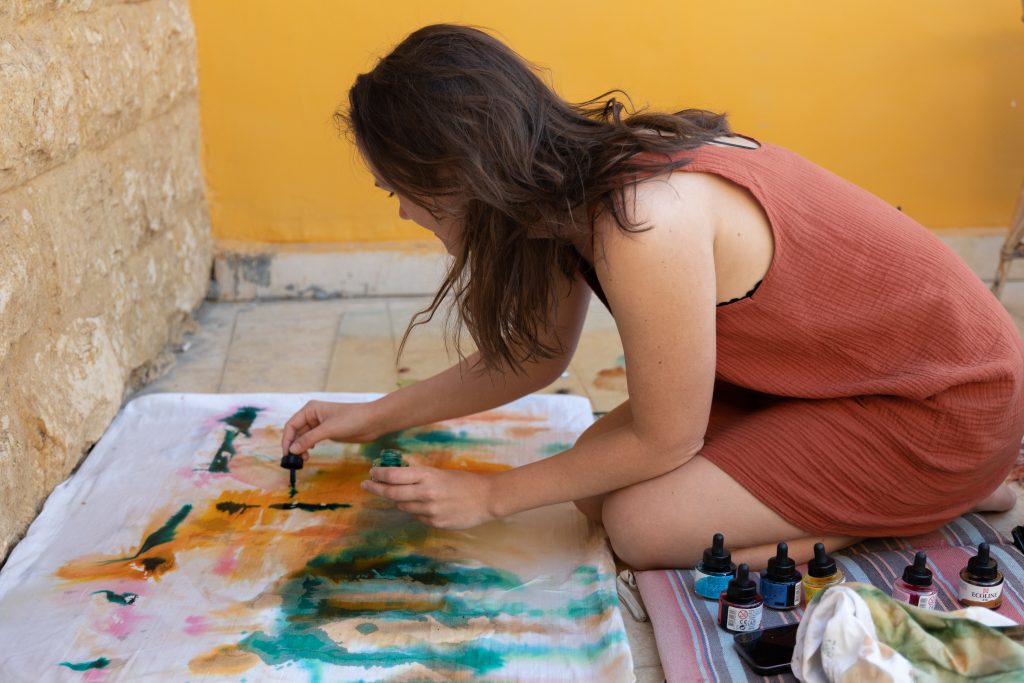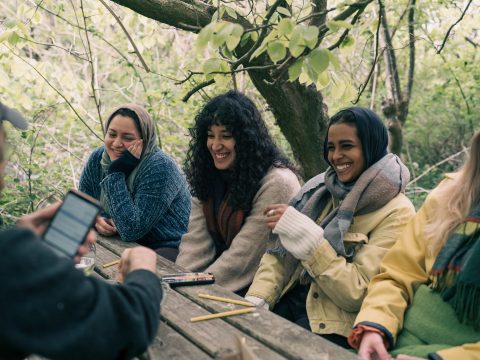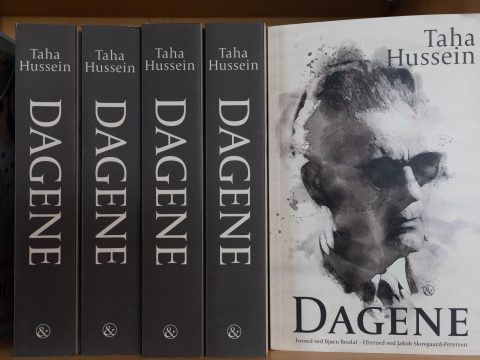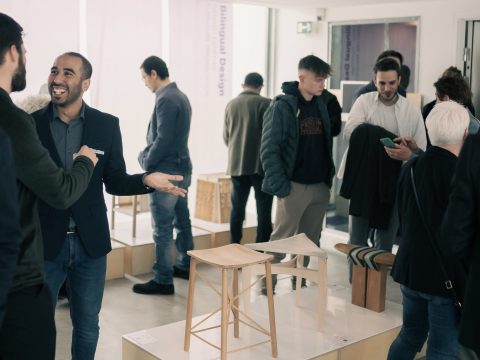
Gig at Yellow Tape
November 17, 2021
Making new ways
December 20, 2021Eight artists, two cities, two weeks and a river were the main elements in the program of the first DEDI Artists’ Symposium, “After Confinement – At Tale of Two Cities”, resulting in overwhelming inspiration and reflections.
By Isabel Moeller
An artist talk by the prominent Egyptian artist Khaled Zaki in his atelier. This was one of the memorable experiences that the group of four Danish and four Egyptian, young visual artists had in Cairo during the first two days of the Artists’ Symposium 2021. After having visited a number of galleries including his exhibition, “The Return”, at Ubuntu Gallery, the group met with Khaled Zaki himself. His works draws upon numerous sources, ranging from ancient Egyptian statuary to Italian renaissance sculpture and Egyptian modernism and are reflecting how rich a heritage Egyptian artists have to draw upon.
The theme of the Symposium, “After Confinement – A Tale of Two Cities”, refers to our present state of mind as well as to Aswan and Hanstholm, Aswan being the next stop for the artists while in Egypt. The coastal village of Hanstholm will follow in May next year, when the second part of the Symposium takes place at the North Atlantic Lighthouse.
The two days of introduction to the art scene in Cairo were followed by the trip to Aswan that was reached by train. While riding 850 kilometers along the banks of the river Nile and getting a sense of its magnitude, the participants also got a chance to get to know each other. And more so than initially planned, since the train was delayed five hours so the 17 hours long trip also led the artists to entertaining each other with games and magical tricks.

While the artists stayed in Cairo they visited Khaled Hafez i in his atelier for an artistic talk about his work and inspiration. Photo by Rowan El Shimi // DEDI
The movement
“There is no doubt that in both Aswan and Hanstholm, water is vital to how people live. And what they live off, and how the city is designed,” Sidsel Ladegaard says after having spent a couple of days at the Nubian Cataract, a lodge like, secluded hotel outside Aswan city overlooking the Nile, the rocky banks and the desert.
Sidsel Ladegaard is a sculptor and her fascination by the movement of water was the main inspiration, when she developed the project for the application to be selected for the Symposium.
“Water is a mean of transportation and my focus is on how to make physical art that can move between two places,” she explains.
During the eight days long stay in Aswan, she worked on creating a sculpture out of handmade glass beads. Pondering the question how small a sculpture could be while still having a justification as art, she was experimenting with the seize of sculpture.
The filmmaker Julie Nymann shares the fascination of water. Among her works is a film, Lungs of Salt , shot underwater in the seas of Denmark and she was planning to dive in and produce underwater footage of the Nile. Meanwhile, her staying in Aswan provided her with new ideas.
“I am exploring dryness; the drought and the lack of water that we see in this region of the world,” she explains.
The reed along the Nile also caught her attention.
“When I saw the Papyrus plant, which the ancient Egyptians used to make paper of, it reminded me of the vegetation on the Danish shores. This could be my visual link between the North Atlantic Ocean and the Nile,” she says.

The participants of DEDI’s Art Symposium are sharing a meal at the Nubian Cataract, in Aswan. Here they stayed together for ten days. Eating, talking, researching and exploring together. Photo by Rowan El Shimi // DEDI
Lost in creativity
Reflecting that, visual artists of today are expressing themselves through a wide of media, the participants of the Art Symposium are working with photography, oil painting, sculpture, textile, animation, installations and games in their projects.
“Meeting new artists and learning about their methods helps me get new inspiration,” Ruwan Hamdy says. She herself is focusing her work on photography.
“Julie Nymann, for example, is a photographer. Meanwhile, she is also making films and she is making them in a conceptual, contemporary way. Her installations are also something that I have been interested in, so to see how she works is inspiring me and makes me want to use this experience in my own work,” Ruwan Hamdy says.
During the eight days in Aswan, each artist was working in the common space. Being able to follow the creative process of colleagues and listening to their considerations about their work was an important part of the Symposium.
“It is easy to follow different artists and see their final work. But being around each other for this amount of time, allows you to look into the processes and watch how the others are working. From the idea in seed, to the research, planning and execution. That is extremely inspiring to me, because it gives me new ideas,” Lot Winther says.

Lot Winther painting in Aswan. Photo by Rowan El Shimi // DEDI
“My biggest take-away, so far, is that I’ve realised I can let go and get completely lost in creativity. This came to me by looking in the others’ sketchbooks and hearing about their thoughts and ideas,” Lot Winther explains.
Silver linings
To Ruwan Hamdy, the people in the cities and the human experience of confinement is more essential than the locations of Hanstholm and Aswan.
“I have been focusing on the links between them in a more metaphorical way in terms of the confinement during the pandemic,” Ruwan Hamdy explains.
“It doesn’t matter where we were, we’re all human beings and the pandemic is an experience that we can all relate to. We have all been through the same phases like nervousness, loosing track of time, being cautious, trying to get back to normality even though we experienced them differently,” she adds.
Her project is to create a photo series on the reflection of her own silver lining during the pandemic and to create a space or a setting where parallel universes meet, where Hanstholm and Aswan meet in lockdown, and reflect local stories and silver linings.

The stay in Aswan led to many talks, both professional and personal, and brought the participants closer together. Photo by Rowan El Shimi // DEDI
To Noran Fikry, who is an animator and describes herself as an introvert, lockdown was initially a gift. Since she doesn’t like to go out much and felt she got the perfect excuse.
But as lockdown continued, she realised that it wasn’t good for her.
“Later I felt deprivation from the sun, from the touch of other people. I want to express this transition of perspective in this project. An introvert person taking advantage of lockdown, but then realizing that this is not healthy for them,” she explains.
Opening doors
By bringing the eight artists together, DEDI also aims at establishing connections and facilitating cooperation further on. This was also important to Julie Nymann who herself started her career in USA and has worked and exhibited several times in Istanbul.
“I am very keen on not getting stuck in the art scene in Denmark and I am hoping that this can be the beginning of me exhibiting here in Egypt and for the Egyptians to exhibit in Denmark,” Julie Nymann says.

Showing your work to the world can be scary. But the artists agree that this is what can help you take it to a new level. “when you see other people looking at your work, you can see if it works or not”, Julie Nymann says. Photo by Rowan El Shimi // DEDI
The DEDI Artists Symposium 2021 took place from November 5 to November 19. The eight participants were selected among 28 applicants by Art Historian, Curator and Researcher, Mette Bielefeldt Bruun, and PhD and associate professor at AUC, Haytham Nawar. They also facilitated the Symposium.
Watch Rowan El Shimi’s video about the Symposium:
List of Participants:




